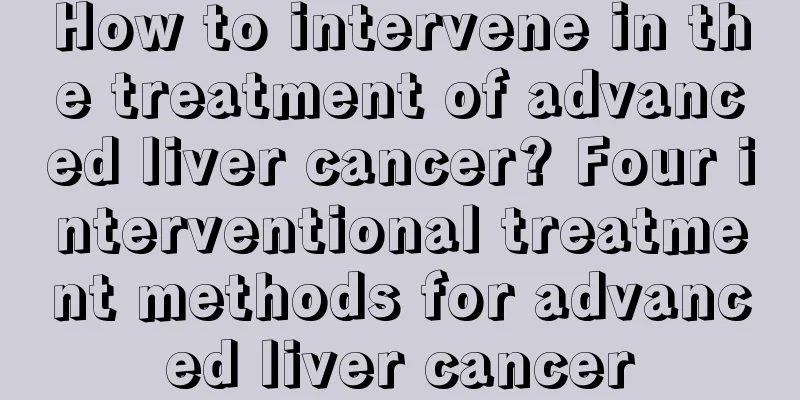How to intervene in the treatment of advanced liver cancer? Four interventional treatment methods for advanced liver cancer

|
In the treatment of liver cancer, interventional treatment is often used, namely interventional treatment of liver cancer. Interventional treatment of liver cancer is a minimally invasive treatment method that uses a tiny channel with a diameter of several millimeters on the blood vessels and skin, or through the original channels of the human body, to treat the local lesion under the guidance of imaging equipment (angiography, fluoroscopy, CT, MR, B-ultrasound) without exposing the lesion through surgery. It should be noted that liver cancer patients should not be too anxious when choosing interventional treatment. Don’t be too “anxious” about liver cancer intervention When liver cancer patients undergo interventional treatment and their liver function is poor, do not be anxious or force yourself. The vast majority of liver cancer patients in my country have concurrent liver cirrhosis, and liver cancer develops on the basis of liver cirrhosis. Before liver cancer patients undergo interventional treatment - transcatheter arterial chemoembolization (TACE), they must fully evaluate their liver function, because interventional treatment will cause a certain degree of damage to liver function. If the liver function is very poor before the operation, interventional treatment may even cause liver failure. The quality of life of liver cancer patients depends mainly on liver function, not the size of the tumor. Aggravated liver function damage often leads to a sharp decline in quality of life, and it is very easy to induce serious complications such as ascites and upper gastrointestinal bleeding. In addition, the recurrence rate of patients with poor liver function after interventional treatment is also higher than that of patients with better liver function. Next, let’s learn about the four interventional treatments for mid- and late-stage liver cancer. Four interventional treatments for advanced liver cancer 1. Transarterial chemoembolization (TACE) Percutaneous transfemoral hepatic artery embolization is the first choice for patients with liver cancer who cannot undergo surgery. The principle is based on the fact that 25% of the blood supply to normal liver tissue comes from the hepatic artery and 75% comes from the portal vein, while the blood supply to liver cancer nodules comes almost entirely from the hepatic artery. Theoretically, if the hepatic artery branch that provides nutrition to the tumor is cannulated and embolized, it can not only block the blood supply to the cancer tissue and limit tumor growth, but also cause necrosis and shrinkage of the cancer tissue without causing liver failure. However, liver cancer still has portal vein blood supply and extrahepatic blood supply, and the blood supply situation is very complicated, such as the blood vessels wrapped in the greater omentum and the blood vessels on the diaphragm, which are beyond the reach of interventional embolization. For some people, the embolization of the cancerous blood vessels is not as good as expected. 2. Alcohol injection method pEI was developed in 1982 and is mainly used to treat small liver cancer. Anhydrous alcohol injection therapy is to insert a puncture needle into the tumor body through the skin under the guidance of interventional ultrasound, and inject anhydrous alcohol or a hardener. The main mechanism of action is to use anhydrous alcohol to quickly dehydrate and fix the tumor tissue, causing ischemia and necrosis of the tumor tissue. This method is simple to operate, less painful, less complicated, and low in cost, but it also has side effects such as easy diffusion during injection and liver damage. 3. Percutaneous microwave coagulation therapy (pMCT) It is not only suitable for small liver cancer, but also for middle and late stage liver cancer, the combination of multi-level, multi-needle, multi-point, multi-power and time can achieve the effect of eliminating tumors. Moreover, the stimulation of coagulated necrotic tumor tissue can enhance the body's immunity and regulate residual tissue cells or those that are still in the process of canceration, opening up a new way for the treatment of liver cancer. 4. Permanent implantation of radioactive particles between tissues It is a new method for treating liver cancer. Some people in the medical field have vividly called it "particle knife". It uses minimally invasive methods such as ultrasound intervention to directly apply multiple packaged radioactive isotopes with certain specifications and activities into the liver cancer tissue through a source applicator or source catheter. The radiation sources are arranged in a certain pattern according to the size and shape of the tumor, and the tumor tissue is irradiated at a close distance and with a high dose to achieve the purpose of curing the disease. |
>>: What are the typical early symptoms of lung cancer? Three typical early symptoms of lung cancer
Recommend
Methods of breathing and pushing during childbirth
It is very painful for pregnant women to give bir...
What is the best way to check for neuralgia?
Headache is a very annoying symptom. The occurren...
One side of the ear is blocked
Many nerves inside the ear are closely related to...
How to make up for staying up all night the next day
Staying up late is a behavior that is very harmfu...
Can gout patients eat loquat
Loquat is a common tropical fruit. It has high nu...
What causes pancreatic cancer
Pancreatic cancer is a serious malignant tumor wi...
Body odor is inherited
What annoys people is the smell of their own body...
Why does frequent bowel movements caused by colitis lead to colon cancer?
Why does frequent bowel movements caused by colit...
What are the advantages of biological treatment for nasopharyngeal carcinoma
What are the advantages of biological treatment f...
Can leg shaking help slim down your legs?
We often hear that leg shaking can slim the legs,...
What causes bilateral kidney stones?
Many friends will find that they have bilateral k...
What are the effects and functions of men eating placenta?
The placenta has many functions and effects for m...
What to do if clothes are damp and smelly
In the summer, apart from the hot weather, it is ...
Sunbathing can effectively help you prevent ovarian cancer
Ovarian cancer is a disease that can seriously th...
How to treat ascites in late stage of liver cancer better? How to care for ascites in late stage of liver cancer
Liver cancer is a complex malignant tumor. Genera...









